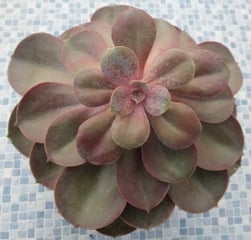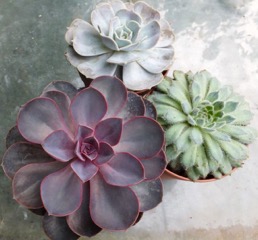
“Why are you growing houseleeks in your greenhouse?” said a friend looking at some Echeverias I had around the base of a Bougainvillea. An easily made mistake for these are a fine example of parallel evolution. Houseleeks are temperate plants designed to survive conditions as harsh and impoverished as crevices of dirt on rock-piles or roof. The Echeverias, or Mexican houseleeks as you might call them, come from the drier regions of Central America up to California where they’ve evolved to fit the same situation, just with a lot more sun.
These are easy care plants, robust if kept warm, happy in our dry air indoors as houseplants and so especially convenient as most are also compact and sit neatly on sunny windowsills. They’re thus good for children, and for the office. And also for the connoisseur wishing for a fine collection as there are many, more than five dozen species, all similar yet each varying in a remarkable number of attractive ways: smooth, hairy, grey, green, purple, metallic, oak leaved etc.
Even better, almost all Echeverias remain compact so a collection of several does not take much space. As I wrote above these are handy around the base of larger plants in containers. However a collection of say a dozen or so on a gravelled bench would be most attractive in itself. The interest is increased when the symmetrical architectural rosettes send up their intricate brightly coloured flower spikes though these seem almost a distraction to the main show, sort of fireworks over a cathedral.
Indeed, it is the perfect form of the plant that makes these

appealing thus be careful the usual troublemakers such as snails and woodlice do not have a chance to damage. And water sparingly and from underneath as marks on the leaves will detract. Their compost needs to be free-draining, a mix of fifty fifty sharp sand or grit, with leaf-mould and loam or ericaceous compost.
Although you could grow these from seed this is not easy and rather slow. Fortunately these are also multiplied more rapidly and easily by detaching the succulent leaves, allowing the wound to dry and heal before potting these up, preferably with bottom heat.


